Some news from the Hamburg band who were previously known as ‘The Band with no Name’. They are back with some band member changes and a new name. Let’s hear it for Steel Butterfly.
You can connect with them here on Facebook
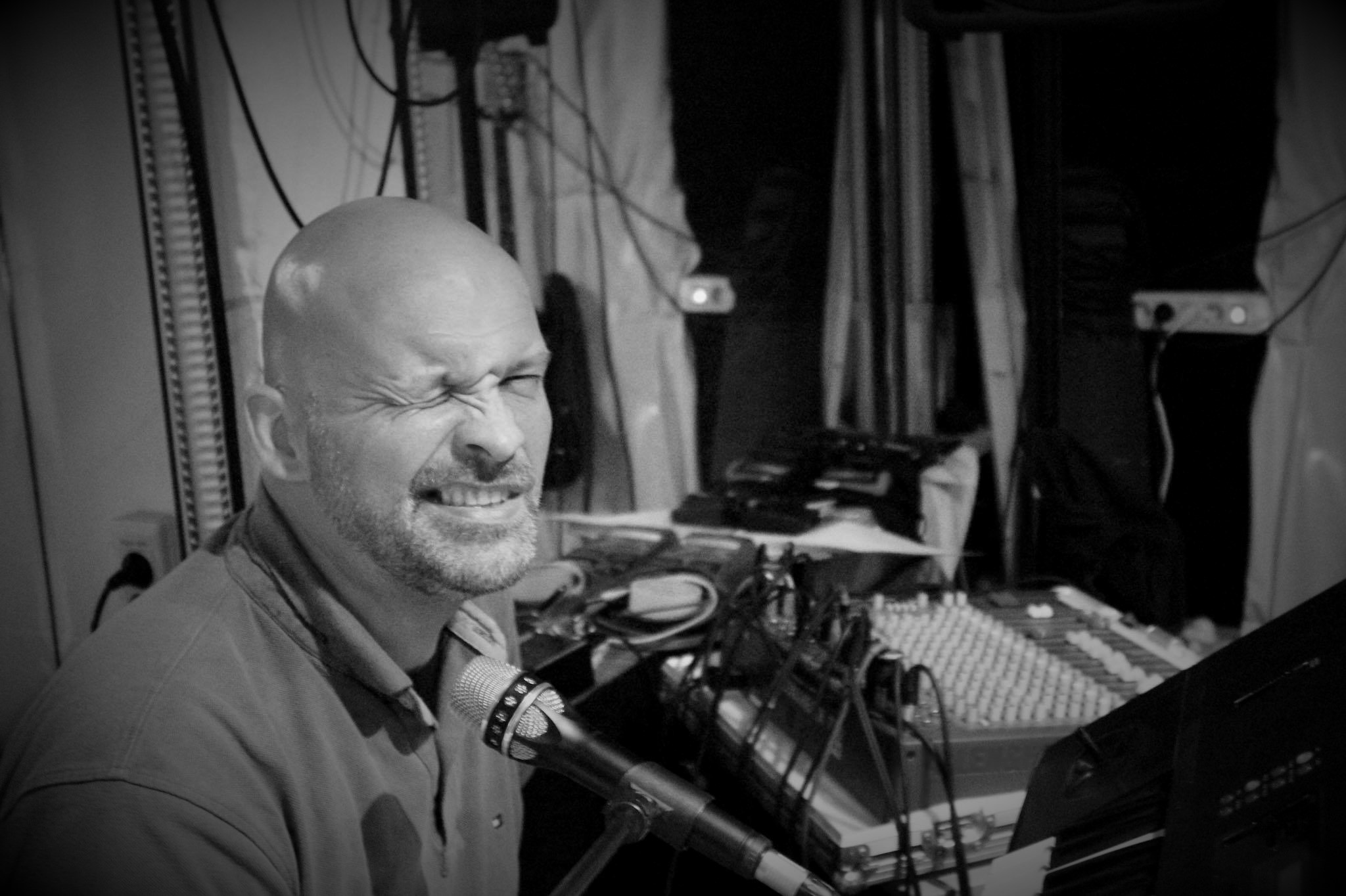
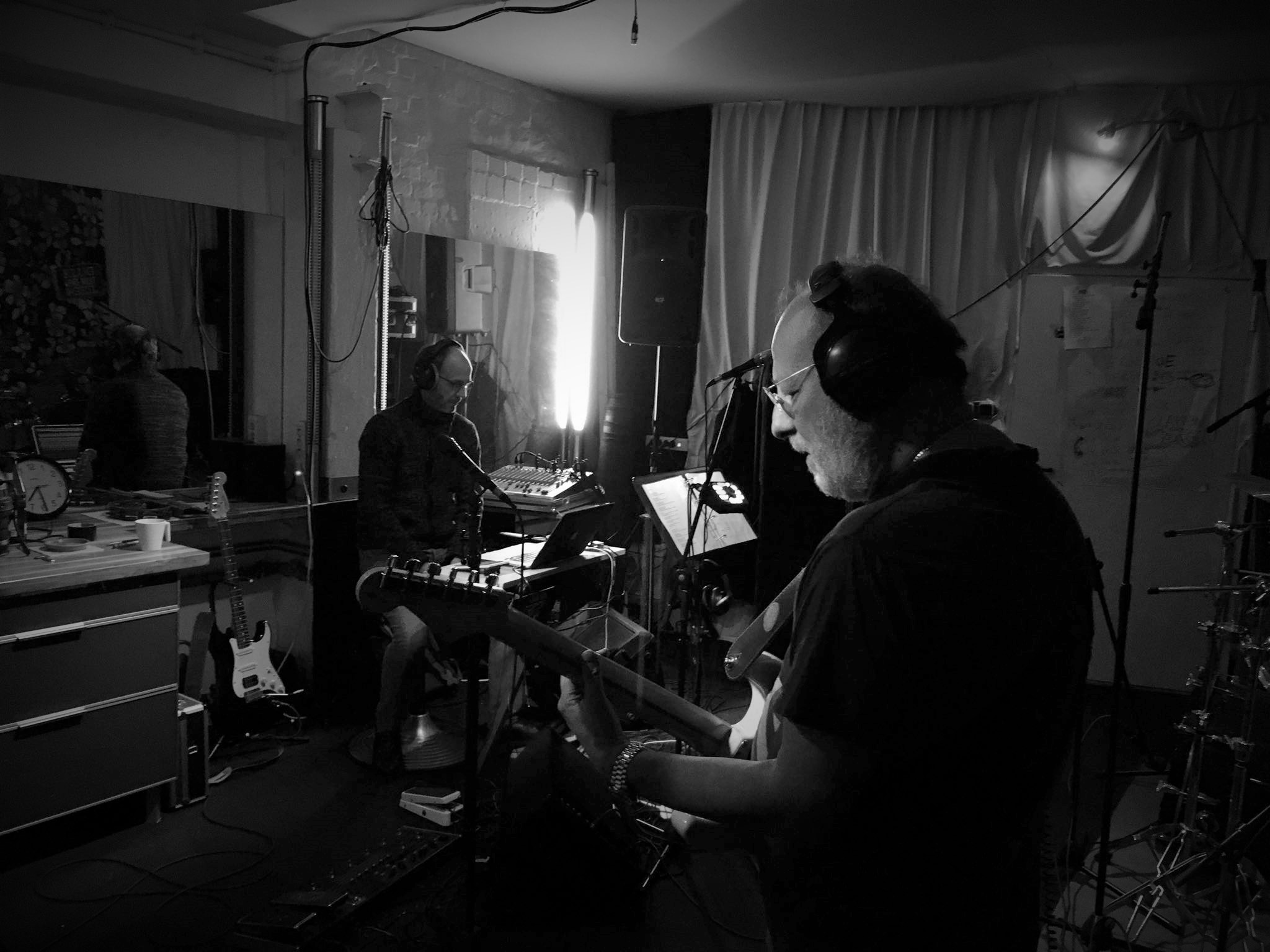
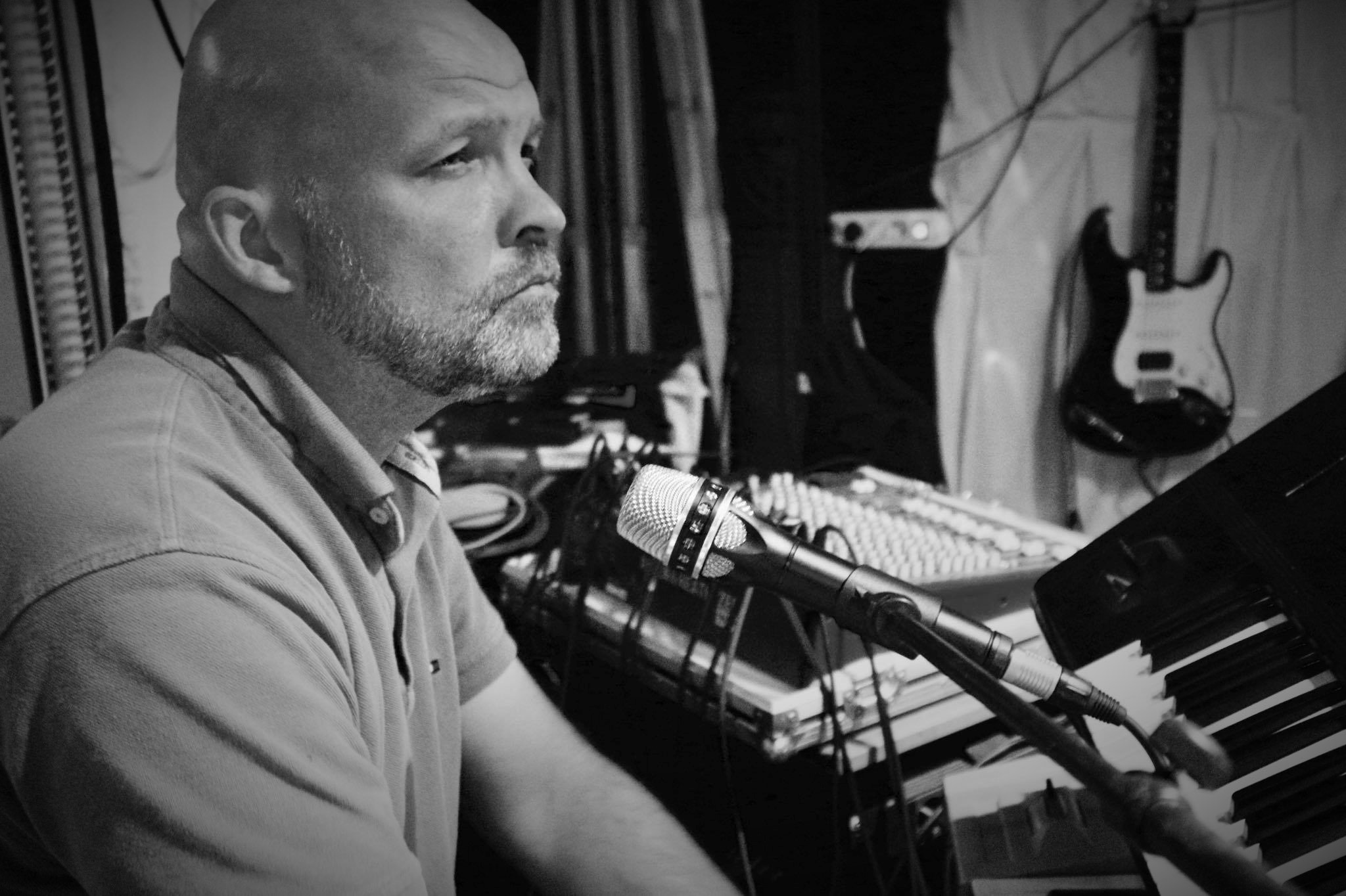
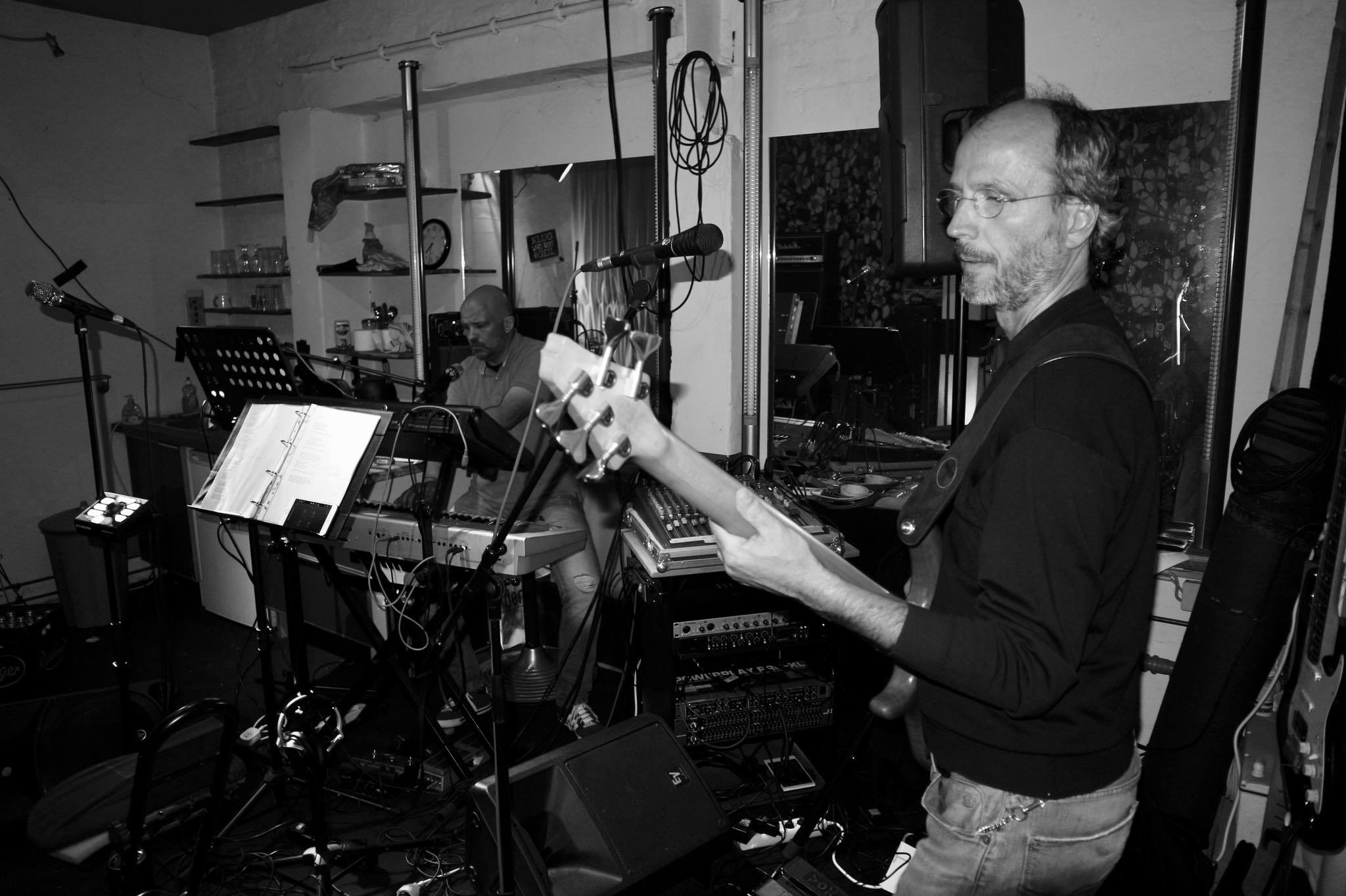
Your Custom Text Here
Some news from the Hamburg band who were previously known as ‘The Band with no Name’. They are back with some band member changes and a new name. Let’s hear it for Steel Butterfly.
You can connect with them here on Facebook
This is a checklist that I usually give to a client before they come in to record. It covers most situations, such as being fully rehearsed with the arrangements clear through to copyright clearance and having all accessories ready and working.
The idea is that the client will waste as little of their precious time as possible by being fully prepared before the session starts.
Are you fully rehearsed?
For example, the vocalist should ensure that all potential mistakes in the vocal tracks are corrected before recording. Or the lead guitarist can perfectly play the solo from start to finish
Are the arrangements finalized?
You can make a great song AWESOME with a killer arrangement. So spend some time deciding if there are things about the song that could be changed to make it have even MORE impact
Have you settled any sound recording copyright issues in advance?
Are all instruments and accessories ready?
Guitarist checking the battery status of their gear; or bring extra batteries in addition to the power adapters in case of accidental malfunction
Vocalist and backup vocalist printing the lyric sheets in advance
Drummers making sure their drum sticks work or in good condition
Check for serious tuning problems in case of guitar strings and replacing faulty strings days before actual recording
Is the tempo of every song confirmed?
One of the biggest time-wasters in the studio is recording at the wrong tempo. That’s why you should take time to identify the best tempo for the song. Once you start recording, you can’t go back and change the tempo
Are song demos uploaded?
For the producer - As you listen to the song, ask yourself a few questions. Does it need to be faster or slower? What instrumentation do you hear in your head? Does the arrangement need to change? Do the transitions work? How about the chord structure? Let your imagination run with it for a few days
New drum skins fitted (if required)
Spare set of sticks
Organize a second snare drum for tuning options
Organize a second set of cymbals for options
Are the guitars setup and restrung?
Is the bass setup and restrung if required?
Do you have a spare set of strings for any guitars?
Print out the lyrics (3 copies)
write up the lyric sheets for your songs, including chord changes
Are the backing vocals parts written in advance and rehearsed?
Have you organised the production budget and payment schedule?
Have you prepared a complete list of credits in the recording project?
https://www.audiorecording.me/music-production-credits-in-recording-essential-documentation.html
Below is how you are going to fill up the details:
Date started– the date that the recording started
Song title– the official title of the song. If the song is copyrighted, use the title registered
Music publisher/writers – who wrote the song as well as the publishers. Sometimes artist and producers rush to the studios without giving proper credits to the songwriters and publishers. This can result to a legal issue particularly if the labels/artist/producers did not make an agreement with the publisher to use the song. Bear in mind that if you did not write the song, you have to ask permission before you can use it whether it’s for non-commercial or commercial reasons
Original/Cover – if the artist wrote the song, it is their original work. Otherwise its cover; the record producer should know this so that proper licensing procedures are implemented. Recording studio engineers should discourage recording of cover songs without proper authorization or license
Artist– the name of the artist or band
Album- if you are recording an album project, write the album name
Label– the name of the label, if the project doesn’t have label, use the owner of the sound recording copyright (in this case the artist if they are the one financial the entire sessions)
Producers – the one who is responsible for approving and disapproving the recording take. Sometimes the label hires producers or it can just be the artist themselves
Studio – name of the recording studio
Engineers – the name of the recording engineer in-charge; including the assistant if applicable
Operating system– the OS used by the computer to record the tracks
DAW– the recording software used e.g. Reaper, Pro tools, Cubase, etc.
Bit depth– e.g. 24-bits, 32-bit float. Never use 16-bit when tracking
Sample rate– e.g. 44.1 KHz, 48 KHz, 96 KHz, 192 KHz. Never use less than 44.1 KHz
Audio Interface – the analog to digital hardware interface used, e.g. Focusrite Saffire Pro 40 or DigiDesign Mbox.

Example track details form
Get a copy of all track recordings in highest resolution (usually 24bit 44.1KHz - don't ask for a CD; this is 16 bit quality)
https://www.audiorecording.me/best-sample-rate-and-audio-bit-depth-for-recording-projects.html
Ambient is the de-emphasis of traditional melody, rhythm, and form and the emphasis and exploration of sonic characteristics such as timbre and texture.
Ambient is a deceptively simple style of music and whilst it is generally possible for anyone to make it, the trick is to make memorable ambient - and there lies the difficulty. Making ambient requires a different set of listening skills - deep listening, as coined by Pauline Oliveros. Focus on areas that most people don’t and bring those elements to the front using the recording process
Start by listening to ambient music you like. Listen very carefully. Then listen some more. There's no right or wrong way to create. There are people who make ambient music with guitars and digital delays or synthesizers and lots of reverb or people who use field recordings processed in post production. It is generally repetitive and slow moving, like a meditation.
Brian Eno is keen to embrace a sense of “doubt and uncertainty” and I can support that. My compositions often start just with a simple melodic idea. Other parts spring from there, often as the result of experimentation — which leads to happy and not-so-happy accidents!
For me the world of Techno and Acid is just as important as the world of Ambient and Drone - they all come from the same place. It’s all music in which to lose yourself. A Techno record can have just as much impact as an Ambient record. Removing the kick from a Techno record in a club just for a minute can have as much impact as a deep Ambient track - and I find that very exciting.
Ambient, and drone even more so, is less about the melody, rhythm, or compositional structure and more about the atmosphere and the timbre. The main tools are sound design (finding the best combination of timbres), lush reverb, and modulation to introduce subtle variations.
Ambient imagery
Tone and timbre are really important in Ambient music. Sounds generally develop over longer time spans so it is important for the sound to remain interesting by use of filter sweeps, LFO, LowFi, and interactions with other pitches.
Brian Eno said that Ambient music "is intended to induce calm and a space to think" - it should have enough detail that you can actively listen to it without getting bored, but not so much that you can't ignore it whilst it's playing.
Play with extreme contrasts in volume, in texture and timbre. Try to create a song where each track uses some form of heavy distortion. Alternatively, compose a track where every sound has a drawn out and soft attack. Then experiment with juxtaposing those two elements within the same song. Experiment with automation of panning, volume, EQ and effects parameters over long periods of time. Experiment with dynamic cross fading between different dynamic layers using the Mod Wheel.
In a particular melodic or harmonic line, consider replacing the instrumentation for that line in one part of your song. For example, if your guitar has a harmony or rhythm part during the first verse, pass that part over to a piano during the second verse.
In Ambient, the rhythm together with call and response are less used but importantly the layers must work together synchronously - blending together to create more a complete soundscape punctuated by subtle noises such as filtered noise washes or field recordings. Spend some time recording sounds from your home or neighbourhood - and find new ways to include these sounds into your music.
The bass line becomes a deep drone, with the colours of its harmonics being emphasised gradually using filtering or resonators. Try limiting your song to only a few chords, or a few simple melodic phrases. Remember that you still need to keep the music engaging - and hopefully interesting - for the listener!
Ambient music in its purest forms usually has no detectable tempo. The music should be thought of as a journey during which some events take place. rather than being structured around a regular tempo with strong beats, the music is punctuated by parts which grow and then fade away leaving a space which is equally important.
Try composing a tune with no discernible meter or tempo. Or try composing in a new time signature such as 7/8 or 5/4
Ambient pieces can be very long - as long as you want in fact. However, there are usually graduated sections which appear perhaps on top of a common theme such as a long drone. This gradual fading in and out is what gives Ambient its form.Think of a tree growing with branches appearing and finally leaves sprouting which may flutter in the wind.
Try working with a more simple or a more complex musical form. Try creating static tracks - tracks that repeat, unchanged for long periods of time. These contrast well with the other tracks that might be changing around them. Sometimes, it is useful to disrupt expectations in your music because it can cause the listener to sit up and take notice.
Ambient music almost always uses spatial characteristics such as stereo spread (the space between your speakers) and perhaps surround sound, delay (for distinct repeats), reverberation, as well as pitch or spectral space (the distance between a low note and a high note, or a band-passed sound and a broadband sound).
Think carefully about mix depth to avoid two-dimensional pieces.
To bring sounds to the foreground - louder, brighter (boost HF content), dryer or subject to rapid changes
To send sounds to the background - quieter, darker, more reverberant.
When writing think about where each element should be placed. Draw them in a placement box
Organizing your sample library is always problematic. When you're on a roll and want to find a specific sample quickly but can't remember where it is.
Well, perhaps Coggle can help.

Coggle is a freeware mind-mapping web application. Like other mind-mapping software, Coggle produces hierarchically structured documents, like a branching tree.
What this means is, at the least you will be able to layout your sample folder structure so that you can decide, in a simple visual way, what structure will best suit your style of music.
Here is my complete folder structure, including business and client folders.
complete folder structure
here is a view of part of my Sample Library structure
Trello is a collaboration tool that lets you organise your projects into boards. In one glance Trello tells you what's being worked on, who's working on what, and where something is placed in a process.
Trello lets you lay out information across a Board which can contain many Lists, each of which can hold many cards into which you can add comments, upload file attachments, create checklists, add labels and due dates, and more. Best of all, it's free (unlimited Boards, Lists, Cards, Members, Checklists, and attachments).
I have found that using Trello to help me remember and comment on each step of my music production has been very useful.My Music Project Board hold many Lists, filled with cards, which can be about any aspect of your music production. I have cards covering musical key structure, production notes, sound design tricks, and so on.
Whilst my Music Items board has many cards covering many subjects, what I will show you today is the content of my Master Template list. Each time I work on a new piece of music, I copy this template, rename it with the song working title and place it in my Song List.
The template list is made up of several sections. The first section covers general items about the song as you can see below.
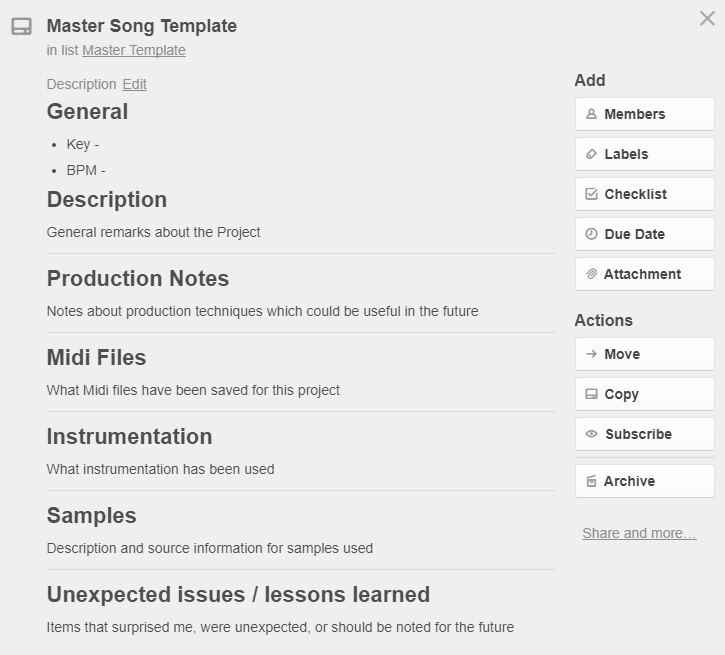
Ableton Master Song Template
General - This section is to hold the Key and tempo of the piece
Description - where I can write anything important about the inspiration and development I followed
Production Notes - relate to the more technical aspects
Midi Files - gives details about what midi files were used in the piece and which have been saved in the project folder
Instrumentation - is where I write about which instruments, VST's, etc. have been used and give details about any special settings
Samples - Samples allows me to give details about any special samples which have been used and keep records for any subsequent sample clearance which may be needed
Unexpected Issues / Lessons Learned - an important part of the learning process is to reflect on what you have learned . What things you were pleased with that you want to remember, and perhaps, things that didn't work out as you wanted that you would rather forget
The next section of the list is a checklist which Trello handles very nicely, Here I check the overall mix of the project. How it feels when I listen to it. The checklist helps me remember important points to watch out for whilst listening.
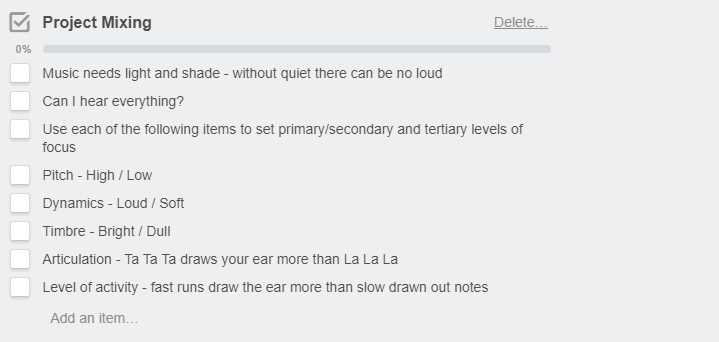
Project mixing section
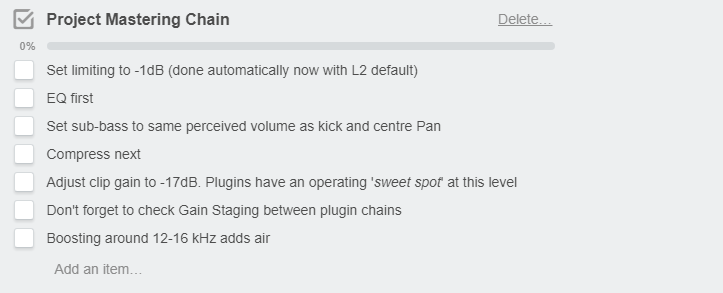
Project mastering checklist
The Mastering Chain checklist reminds me about mastering aspects I need to take care about after the project has been mixed and is ready for mastering.
Set the limiting at -1dB to make sure you don't get distortion from inter-sample peaks and keep a careful eye on gain staging as the signal passes through the signal path.

General Project Checklist
The Project Checklist helps me with project housekeeping. They are all pretty self explanatory.
These are the items we may tend to forget in the heat of the creative moment, but if you have ever gone back to a project after a year or so either for yourself or when a client asks if they could have a different mix of the project, you will be very glad that you followed this little checklist.

Final Project Archiving
The last little checklist could be part of the Project Checklist but I prefer to separate it out as a last little check that I have done all the checks for the project that should be done.
Trello is the perfect tool for this sort of work. I can very easily update the text or add new points to my checklists at any moment. Having these handy whilst working on a new project makes it simple to follow a routine.
When all is finished I simple save as a PDF file in the appropriate computer folder. I also keep a printed version for easy consultation at any time.
If you have any ideas or suggestion about making this process better let me know, and if you would like to use the Music Template yourself in Trello please let me know and I can share it as a public List.
Years ago, Mickey Knight, Diacoustic Lab, purveyor of styli, lacquer blanks, and Gear created this list of laws applicable to Audio Engineers. The list was then distributed at an AES convention in the 1970s when many of the persons on this list were the goto guys in their respective games
Grundman's Law - Bernie Grundman, Mastering Engineer & Educator
Under the most carefully controlled conditions of pressure, temperature, humidity and other variables, the system will perform as it damn well pleases
Knight's Law - Mickey Knight, creator of this list
A pat on the back is only a few centimeters from a kick in the pants
Hidley's Law - Tom Hidley, Studio designer, Westlake Audio
Nothing is impossible for a man who doesn't have to do the work
Duncan's Law - Kent Duncan, Kendun Recorders. Recording and Mastering Facility
When in doubt, mumble
Evan's Law
Every man has a scheme that will not work. See also O'Donnell's Law
Hulko's Law - Lee Hulko, mastering engineer, Sterling Sound, one of the original owners
A theory is better than its explanation
Storyk's Law - John Storyk, Studio Designer
The amount of work done varies inversely with the amount of time spent in the office
Woram's Law - John Woram, Engineer and Author. Propounded by Sci-Fi writer, Arthur C. Clarke, 1962
Any sufficiently advanced technology is indistinguishable from magic
Nordahl's Law - Tore Nordahl, Studer & Neve. Now a consultant
Everything goes wrong at once
Emmerman's Law - Mack Emmerman, Criteria Studios, Miami FL
In a crisis that forces a choice to be made among alternative courses of action, people tend to choose the worst possible course
Tarsia's Law - Joe Tarsia, Sigma Sound, Philadelphia
The obvious answer is always overlooked
Tarsia's 2nd Law - Mike Tarsia, Sigma Sound, Philadelphia (2009)
When booking recording studios, pick any 2 out of 3: Fast | Cheap | Good
You can get your product fast and cheap... but it isn't going to sound good
You can get it cheap and good... but it won't be done fast
You can get it good and fast... but it won't be cheap
Also applies to many other time/cost/quality decisions
Previn's variant of Tarsia's 2nd Law - Andre Previn, Classical and film composer. Submitted by Tim Whittaker (2014)
Do you want it good, or do you want it Thursday?
Snoddy's Law - Glenn Snoddy, recording engineer. Discoverer of Fuzz as an effect. Fuzztone Origin
It works better if you plug it in
Harrison's Law - Dave Harrison, Harrison consoles, inventor of inline console topology
There is always an easy answer to every problem - neat, plausible and wrong
Meadow's Law - Glenn Meadows, Masterfonics
It won't work
Westlake's Law - Westlake Audio, purveyor of Gear and studio systems. Likely attributable to Tom Hidley, who was the owner of the company
The first 90 percent of the project takes 90 percent of the time, and the last 10 percent takes the other 90 percent
Harned's Law - Jeep Harned, founder of MCI
Once you open a can of worms, the only way to recan them is to use a bigger can
Schnee's Law - Bill Schnee, Engineer and Producer
Anything that begins well will end badly. (note: the converse of this law is not true)
Stone's Law - Chris Stone, founder and owner of the Record Plant. aka Farber's Fourth Law
Necessity is the mother of strange bedfellows
Golden's Law - John Golden, mastering engineer: Artisan Sound Recorders, Kendun, K-Disc, and John Golden Mastering (2009)
A man with one watch knows what time it is. A man with two watches is never sure. aka Segall's Law
Perry's Law - Ken Perry, Mastering Engineer (2009)
If the facts do not conform to the theory, they must be disposed of
Garay's Law - Val Garay, Engineer and Producer
An object will fall so as to do the most damage
Kelsey's Law
Make three correct guesses consecutively and you will establish yourself as an expert
Lightner's Law - Bill Lightner, mastering engineer @ K-Disc (2009)
If it happens, it must be possible
Steele's Law
Social innovations tend to the level of minimum well being
Guy's Law
The probability of a given event occurring is inversely proportional to its desirability
Moyssiadis' Law - Dave Moyssiadis, mastering and recording engineer
As soon as you mention something, if it's good, it goes away; if it's bad, it happens
Capps' Law - Capps makes disc recording styli
If it can find a way to wear out faster, it will
Lippell's Law
If a research project is not worth doing, it is not worth doing well
Neumann's Law - Georg Neumann, microphone God
Whoever has the gold makes the rules (see also: Temmer's Law)
Calbi's Law - Greg Calbi, mastering engineer: The Cutting Room @ Record Plant NYC, Sterling Sound, Masterdisc. (2009)
Nothing is as easy as it looks
Marino's Law - George Marino, mastering engineer: The Cutting Room @ Record Plant NYC, Sterling Sound
Everything takes longer than you think it will
Todrank's Law - Bob Todrank, purveyor of Gear
There are two types of people: those who divide people into two types, and those who do not
Brosious' Law - Ham Brosious, then with Audiotechniques, Gear Purveyor. Now with Digibid, Gear Purveyor of the new Millennia n.b. Ebay ended up eating Digibid's lunch. They are now toast
The components you have will expand to fill the available space
Ingoldsby's Law - Brian Inglodsby, MCA
You cannot determine beforehand which side of the bread to butter
Merten's Law
The more time you spend in reporting on what you are doing, the less time you have to do anything. Stability is achieved when you spend all your time reporting on the nothing you are doing
Sax's Law - Doug Sax, The Mastering Lab
All laws are basically false
Zentz's Law - Alan Zentz, Mastering Engineer and studio owner
Inside every large problem is a small problem struggling to get out
Ludwig's Law - Bob Ludwig, Mastering Engineer
The other line moves faster
Dozier's Law - LaMont Dozier, Producer & Songwriter
Negative expectations yield negative results. Positive expectations yield negative results
Rettinger's Law - Michael Rettinger, Acoustician
Nothing is ever a complete failure. It can always serve as a bad example
Ricker's Law - Stan Ricker, Mastering Engineer, half-speed mastering God
Experiments should be reproducible. They should all fail the same way
Boden's Law
If an experiment works, you must be using the wrong experiment
Hansch's Law - Jo Hansch, mastering engineer: Festival Records-Australia, Kendun, Artisan Sound Recorders, K-Disc, Dinkum
Work expands to fill the time available for its completion
Eberle's Laws
Once a job is fouled up, anything done to improve it makes it worse
No matter what results are expected, someone is always willing to take it
No matter what occurs, someone believes it happened according to his pet theory
No matter what the result, someone is always eager to misinterpret it
See also: O'Donnell's Law
Appears to be part of Murphy's Laws
Fulginiti's Law - Greg Fulginiti, mastering engineer, Sterling Sound, Artisan Sound Recorders, Masterdisk
In a heirarchical organization, the higher the level, the greater the confusion
Reese's Law - Mike Reese, mastering engineer: The Mastering Lab
There are two sides to every argument, unless a person is personally involved, in which case there is only one
Leek's Law
An experiment may be considered a success if no more than half your data must be discarded to obtain correspondence with your theory
Cato's Law
The merchandise you need the quickest will be shipped the slowest way
Gray's Law - Kevin Gray, mastering engineer
In any collection of data, the figures that are obviously correct beyond all need of checking contain the errors
Corrollary 1: No one you ask for help will see the error either
Corrollary 2: Any nagging intruder who stops by with unsought advice will spot it immediately
Simpson's Law
There is a quantity which, when multiplied by, divided by, added to or subtracted from the answer you get, gives you the answer you should have gotten
Berrra's Law / Mark's Law - Yogi Berra
In theory, there's no difference between theory and practice, but in practice, there is
Anderson's Law - Jim Anderson, AES Past President
Nothing takes 5 minutes
Karl's Law - Karl Johnson, Audio Engineer
When time is of the essence, all fixes have failed, and the show must go on, then: one man's buzz is another man's line noise
Hufker's Law - Eugene Hufker, Contributed (2009) by his son, Barry, Hufker Recording St. Louis, MO
If at first you don't succeed, you're using the wrong hammer
Stamler's First Law - Paul Stamler
80% of the problems in audio are caused by a bad connection someplace
Stuart's Law - John Stuart, recorder of more folksingers than you can shake a stick at
The worse they are, the more verses they know
Temmer's Law - Stephen Temmer, Gotham Audio, importer of Neumann Microphones
If I don't make or sell it, it isn't any good
Chinn's Law of Overkill - Rick Chinn, Uneeda Audio (and purveyor of this list)
If it's worth doing, then it's worth overkilling
Wilcox' Law - Peter Wilcox, Wannabe dobro player (by his own admission)
In any endeavor, two thirds of the work is done by one-third of the participants
Blasingame's First Law - Joe Blasingame, Blasingame Audio Productions St. Louis, MO
When operating in the vacuum of a studio, time moves faster than anywhere else in the Universe
Blasingame's Second Law
No matter how fast and effective an audio engineer works, to the paying client it's like molasses
Mortensen's First Law - Dan Mortensen, Dansound
When using recorded music as a test source, the moment when you are finally ready to begin the test always coincides with the end of the song/CD
Simpson's Law - Keith Simpson (2010)
When you reach for the knob, the _____ player stops playing
(a corollary to Mortensen's first law)
Mortensen's Second Law - Dan Mortensen, Dansound
Someone, out of your field of vision, always unknowingly chooses to drop or knock over an object, creating a very loud abrupt BANG!!! at the exact moment you plug or unplug a connector. Good luck figuring out what the hell it was
Chinn's variant to Mortensen's Second Law - Rick Chinn, Uneeda Audio
When you're repairing someone's amp, and they're watching, they invariably blow a stream of smoke over the patient, which makes you wonder if some part just let out its magic smoke. This was more common in the 70s than now, since smoking has been banned in most public places (YAY)
Jaeger's Law - Rene Jaeger, Analog Design Engineer Loud Technologies
The evaluation sample is always in the 99th percentile of the performance range
Welti's Law - Todd Welti, (2009) Staff Scientist Harman International
If you've worked through the problem forwards and backwards, checked your math, consulted your intellectual superiors, and made invocations to the Gods, and still your hardware setup is giving the wrong result, you will find that it's a bad cable
von Recklinghausen's Law - Daniel von Recklinghausen (1925-2011) Technical Director, H.H. Scott and many other companies. Source: obituary, JAES, September 2011
If it measures good and sounds bad, it is bad. If it Measures bad and sounds good, you've measured the wrong thing
Molberg's Law - Keith Molberg, M. Mus. Professor of Recording Arts @ Briercrest College and Seminary - Submitted by Brendan Clace (2011)
If it sounds good, it is good
Boden's Law of ProTools - Mike Boden, (2011) Recording Engineer
Everything's easy, all the time
Pfaeffle's Law - Tom Pfaeffle, Late owner of The Tank Studios (RIP) (who was murdered in a bizarre incident) Submitted by Art Arzaga Jr. (2011)
Digital audio does not exist unless it has been backed up 3 separate times on 3 separate drives
Olmstead's Law - Frederick Law Olmstead, (1822-1903) Journalist and Landscape Designer (did Central Park in NYC)
After all is said and done, a hell of a lot more is said than done!
Trimble's Law - Tom Trimble, Director of Student Unions, University of Toledo. Submitted by Jeff Moss (2011)
Anytime there is a button somewhere, some idiot will try to mess with it
Gaston's Law - Leslie Gaston, (2010) Assistant Professor of Recording Arts, University of Colorado
If you can't figure out why you're not hearing anything, it's because one (and only ONE) button needs to be pushed. The angrier you become, the more obvious the button
Chinn's Corollary to Gaston's Law
In any DAW or digital mixing surface, the button you can't find is on the menu you just visited (and going backwards in the UI is impossible)
Murphy's Monitor Law - Ralph Kaiser (2012) TD, University of Guadalajara
The monitor levels decrease as soon as the show starts
Rubel's Law of Production - Mark Rubel, Instructor & Co-Director (2014) The Blackbird Academy
Great music poorly recorded will always be great; crappy music wonderfully recorded will always be crap
Murphy's Law of Inanimate Reproduction - Tim Franquist (2014) Independent Live Sound Engineer
If you take something apart and put it back together enough times, you will now have enough parts leftover to make another one, but neither one will work
Poole's Law (for monitor mix engineers) - Mikey Poole (2014) Independent Live Sound Engineer
A positive movement of an eyebrow supersedes any movement of a fader or pot
Hawley's Law of Differences - Scott Hawley, PhD (2014) Teacher of acoustics and electronics for audio engineering students. Belmont University, Nashville
Given any two arbitrarily similar sounds, there will always be at least one audio engineer who will claim to be able to hear the difference
O'Donnell's Law of Independent Behaviour - Casey O'Donnell (2014) House Engineer at Hard Rock Live, Orlando
Everyone is entitled to their own wrong way of doing things
Phillips Law of Reverse Mixing - Mark Phillips Professor of Music, Ohio University
Often the best fix for not being able to hear someone is to turn down something (or many somethings)... rather than turning up what you don't hear
Hogan's Law of Time - Teri Hogan President & CEO Sound Services, Inc. Past contributor to Live Sound International
However much time you have is how long it will take
Uploaded by Roger Hembrough on 2017-01-14.
My small tribute to the great Delia Derbyshire for her special day today in Manchester UK.
The piece contains snippets from much of her work woven together to salute her pioneering spirit.
My small tribute to the great Delia Derbyshire for her special day today in Manchester UK. The piece contains snippets from much of her work woven together to salute her pioneering spirit.